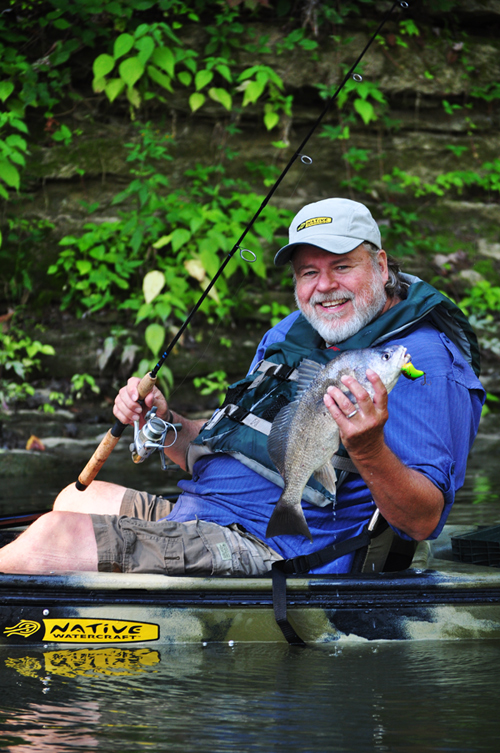Sept.22,2011 By Art Lander, Jr.
FRANKFORT, Ky. – The lower sections of many tributaries to the Kentucky River offer surprisingly good fishing, especially in fall. A good one to try before the weather chills is Six Mile Creek, a 14-mile tributary to the Kentucky River that is an easy drive from the Louisville or Lexington metropolitan areas.
Six Mile Creek rises in northeast Shelby County and flows in a north, northeast direction through Henry County. There’s public access to Six Mile Creek at its mouth, in Lockport, Kentucky. Off KY 389, a concrete boat launching ramp offers a free launch and plenty of room to park.

The best fishing is in the lower two to three miles of the creek, depending on the river level. Six Mile Creek rapidly becomes shallow further upstream, even for canoes or kayaks. River backwater is the major influence on this flatwater stream, which is tree-canopied and has little flow.
As you paddle upstream of the boat ramp, the remote character of the creek unfolds. Songbirds, deer, birds of prey and wild turkeys are frequently observed in the shoreline woods. Six Mile Creek flows through a wide valley, and is flanked by farm fields and wooded hills. An unimproved one-lane gravel road parallels the creek from Lockport to its junction with Ky. 573, passable only in trucks and SUVs with high clearance.
There are deadfalls and submerged logs in the lower end of the stream. The banks are predominately dirt, with short stretches of bedrock.
Boat traffic is minimal. Paddlers will infrequently encounter other anglers fishing from the banks, or anglers who motor up the creek from the boat ramp in john or bass boats.
The stream offers good fishing for different species at various times of the year.
In the late winter and early spring, sauger congregate around Lock and Dam No. 2, and are caught off the rock banks at the mouth of Six Mile Creek. Jigs, live minnows and crankbaits are top sauger lures.
Bass stage in the lower end of Six Mile Creek beginning in late February or early March, depending on water conditions. Anglers pitching and flipping jigs around wood cover and tree root wads are often rewarded with good catches of quality-sized bass.
In the early summer, bass can be caught on spinnerbaits and small plastic baits. All three species of black bass can be taken, but the farther up the stream you paddle, the more likely the opportunity of catching a spotted or smallmouth bass.
Spring through fall, catfish can be caught from the many deep holes in the creek. A good fishing technique is to bounce live bait — nightcrawlers or minnows — off the bottom as you slowly drift down the creek.
Other river fish, such as carp and freshwater drum, are also caught from Six Mile Creek.
In recent years, the Kentucky Department of Fish and Wildlife Resources stocked sauger, hybrid striped bass, white bass and muskies in the Kentucky River to bolster native populations of these species.
“We’re seeing natural reproduction of white bass and sauger in the river, and catches of muskies up to 50 inches long have been reported in the lower pools,” said Gerry Buynak, assistant director of fisheries for Kentucky Fish and Wildlife.
While most of the stockings have been above Lock and Dam No. 4 at Frankfort, floods enable fish to move up and down the river. Fish also move from the Ohio River into the lower pools of the Kentucky River.
Cast a crankbait to the bedrock banks of Six Mile Creek and you’re likely to catch freshwater drum, which put up a spirited fight on light tackle. Drum, often called white perch or sheepshead, feed on small minnows, snails and crayfish found on rock banks.
During the fall, when the Kentucky River level is low, anglers have a second fishing option in Lockport. They may launch their canoes or kayaks on a rock shoal below Lock and Dam No. 2. A steep, unimproved gravel road provides access down to the water, passable only in trucks and SUVs with high clearance. There’s no fee to launch and plenty of room to park.
Anglers are reminded not to paddle into the turbulent water below dams. Boats must stay outside the safety buoys.
There are no special fishing regulations in effect for Six Mile Creek, or the Kentucky River below Lock and Dam No. 2. Statewide size and creel limits are in effect.
Author Art Lander Jr. has been writing about the outdoors since the 1970s. He is a staff writer for Kentucky Afield Magazine.
Lander will periodically profile fishing in accessible small waters in the coming months in the Kentucky Afield Outdoors weekly columns. He will focus mainly on flatwater rivers and creeks, ponds and small lakes — open to public fishing that are ideal for paddle-powered boats such as canoes or kayaks.
-30-
Contact: Art Lander, Jr.
1-800-858-1549, ext. 4414
The Kentucky Department of Fish and Wildlife Resources manages, regulates, enforces and promotes responsible use of all fish and wildlife species, their habitats, public wildlife areas and waterways for the benefit of those resources and for public enjoyment. Kentucky Fish and Wildlife is an agency of the Tourism, Arts and Heritage Cabinet. For more information on the department, visit our website at fw.ky.gov.


Be the first to comment